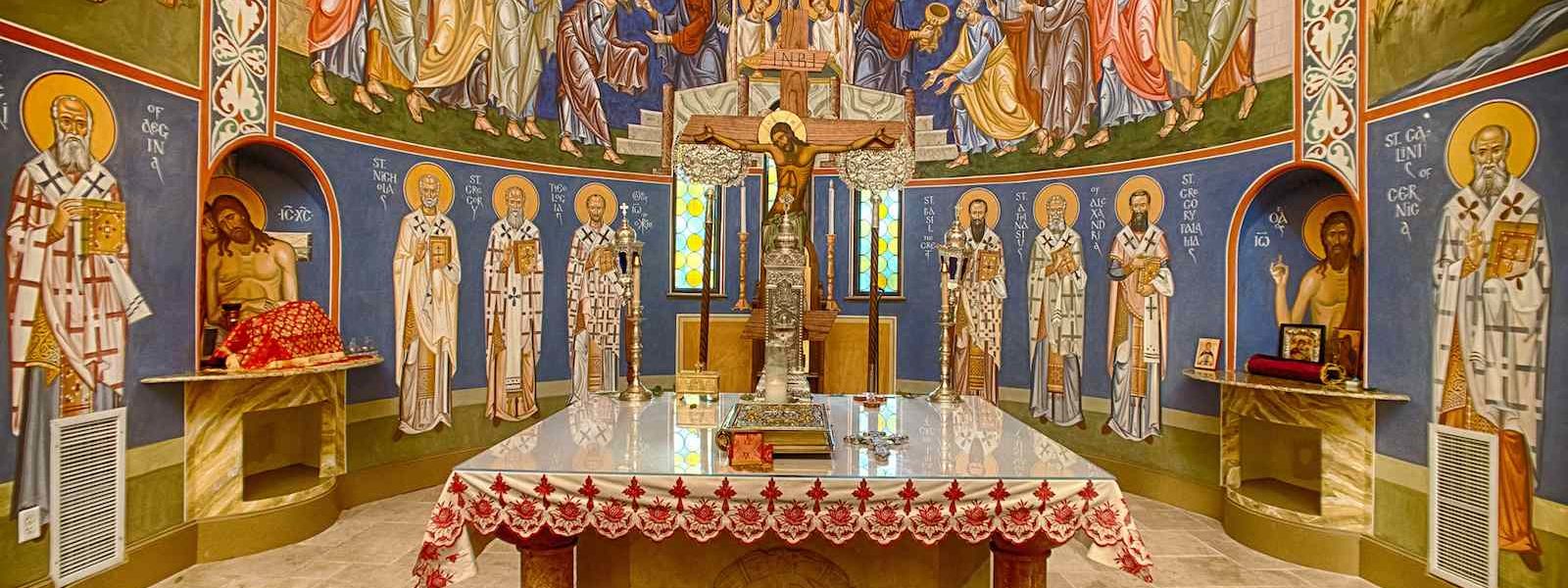Wedding Ceremony Explained
The Sacrament of Marriage in the Eastern Orthodox Church derives from the belief that marriage exists from God’s creation of the first man and the first woman. As such, the couple does not exchange vows, but is united by the grace of God. The marriage ceremony is steeped in ritual and symbolism. Each of the acts which you will observe has special meaning and significance. The ceremony is celebrated as two services: the Betrothal, when the rings are exchanged, and the Crowning (Stephana), when the prayers are offered and the crowns of marriage are placed upon the heads of the couple.
Koumbaro(a)
The koumbaro(a) is a sponsor who is also a guarantor and advisor of the spiritual relationship of the couple.
The Betrothal
The Betrothal consists of a number of petitions the blessing of the rings, and a concluding prayer. The rings are the symbol of betrothal from the most ancient times. During the service the priest blesses the rings in a form of a cross over the heads of the bride and groom three times, then places them on their right hands. The sponsor (koumbaro/a) stands before the couple and interchanges the rings three times. The exchange signifies that in married life the weakness of one partner will be compensated for the strength of the other interchangeably; by themselves the newly betrothed are incomplete, but together they are made perfect; thus, the exchange of the rings gives expression to the fact that the spouses in marriage will continually be complimenting each other. Each will be enriched by the union.
The Candles
The wedding service begins immediately following the betrothal service. The couple are handed candles which they hold throughout the service. The candles symbolize the spiritual willingness of the couple to receive Christ who will bless them through this sacrament.
The Joining of the Hands
The priest joins the right hands of the couple and calls upon God to join these “ Join these, Your servants, unite them in one mind and one flesh”. The hands are kept joined throughout the service t symbolize the “oneness” of the couple.
The Service of the Crowning
The crowning, which follows is the climax of the wedding service. Crowns (Stephana) are symbolic of the great honor and responsibility that attend the establishment of a new Christian family. The new bride and groom are crowned as king and queen of their own domestic kingdom. The kingdom established today is not to be a separate kingdom, but fully integrated in the Kingdom of God. The purpose of living together in it is that that they and their children will achieve salvation by living a true Christian life. The white ribbon joining the crowns indicates that God blesses the couple in relationship to one another, not as separate individuals. The priest takes up the crowns and makes the sign of the cross over the bride and groom three times and places the crowns on their heads. The koumbaro(a) then exchanges the crowns three times as a witness to their union. The couple will wear the crowns for the remaining of the ceremony. The crowns also have another deep spiritual meaning because they also represent the crowns of martyrdom since every true marriage involves immeasurable self-sacrifice on both sides. This will be revealed in the hymns chanted during the ceremonial walk.
The Common Cup
The rite of crowning is followed by the reading of the epistle and the Gospel. The Gospel reading describes the marriage at Cana of Galilee which was attended and blessed by Christ, and for which he reserved His first miracle. There He converted the water into wine and gave the newlyweds. In remembrance of this blessing, wine is given to the couple. This is the “common cup of life denoting the mutual sharing of joy and sorrow, the token of a life of harmony. The drinking of wine from the common cup serves to impress upon the couple that from that moment on they will share everything in life, joys as well as sorrows.
The Ceremonial Walk
The priest and couple will encircle a prepared table three times, in honor of the Holy Trinity. This walk not only represents their first steps together, but also symbolizes their journey through life; the priest leads the couple in the manner they must travel in this journey. The priest holds the Gospel at the head of the procession, reminding the couple the fact that the words of our Lord are to guide them through life. A cross is placed on the encircled table, reminding the couple that the way of Christian living should always be centered on Jesus Christ, who died on the cross for our salvation. The koumbaro(a) follows the priest and couple holding the ribbon that joins their two crowns signifying his/her lifelong moral and spiritual support for the couple. During the ceremonial walk, the choir sings hymns, one of which refers to the Holy Martyrs, reminding the newly married couple of the sacrificial love that does not seek its own, but is willing to sacrifice for the one loved.
The Final Blessing
The priest removes the crowns and gives the bride and groom a final blessing, praying that God will “fill their lives with all that is good” and to bless them for “many years”
